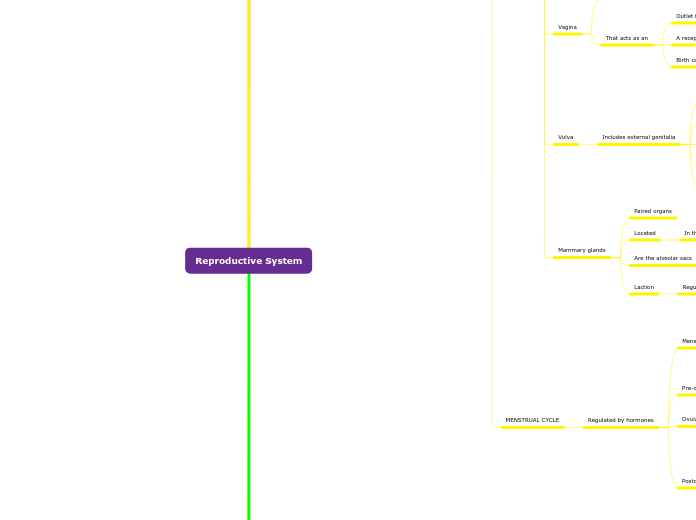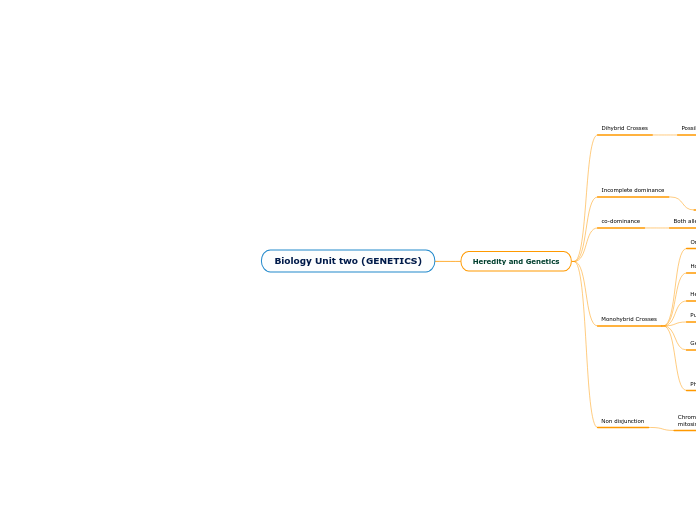Reproductive System
METHODS FOR BIRTH CONTROL
Partial abstinence
Basal temperature
Rhythm
Chemical methods
Spermicides
Hormonal
Physical methods
Surgical sterilization
Intrauterine devices (IUD)
Barrier
Cervical cap
Diaphragm
Male and female condom
DISEASES (STD)
Hepatitis B
Acquired immunodeficiency syndrome (AIDS)
Molluscum contagiosum
Genital warts
Genital herpes
Syphilis
Gonorrhea
Chlamydia
MALE REPRODUCTIVE SYSTEM
Penis
Contains
The urethra
Carries semen and urine.
Copulatory organ
Accesory glands
Secrete the fluid
where the sperm will move
Bulbourethral glands
Viscous and alkaline liquid.
Prostate
Provides 25% of the semen volume.
Seminal vesicles
Provide 60% of the semen.
Semen
Made up
Accessory gland secretion
Sperm
Ducts of the male reproductive system
Function
Protect and conduct sperm
Urethra
Ejaculatory duct
Vas deferens
Drives sperm
Epididymis
Substance are produced for the maturation of sperm.
Testicles
Produce
Testosterone
In the scrotal bags
Inside
Seminiferous tubules
Sperm develop
FEMALE REPRODUCTIVE SYSTEM
MENSTRUAL CYCLE
Regulated by hormones
Postovulatory phase
No fertilization
Menstruation occurs
Hormones decrease
Ovary rupture
Corpus luteum is formed
Begins to produce estrogens and progesterone
will provide nutrition in the event of fertilization
Ovulation
Estrogen production reaches its peak.
This triggers the production of LH in the pituitary.
Causing the rupture of the follicle in the ovary releasing the oocyte.
Pre-ovulatory phase
In the uterus, the endometrium begins to develop again.
Thanks to the secretion of estrogens.
Menstrual phase
Lasts from 1 to 5 days
Levels of estrogen and progesterone decrease.
Causing the detachment of the endometrium.
ORGANS
Laction
Regulated
By the prolactin and oxytocin hormones
Are the alveolar sacs
Produce milk
Transport it through ducts until it ends in the nipple.
Located
In the anterior part of the torax.
Paired organs
Includes external genitalia
Pubic mound
That acts as an
Birth canal.
A receptacle for the penis during intercourse.
Outlet for menstrual flow.
Tubular organ 10 cm long
Functions
Implantation of the ovum
Allow pregnancy and delivery
Consists of 3 portions
The lower or cervix
Continues with the vagina.
The body
The fertilized ovum is implanted-
The upper or fund
The fallopian tubes flow
Inverted pear-shape organ.
The time it takes for the oocyte from ovulation
To reach the uterus
6 to 7 days
On its way through the tubes
The oocyte can be fertilized
Is when it receives the name of ovum
Tubular organs 10 cm long
Amount
Only
400 will mature and be expelled.
At puberty
40 thousand
Girl is born
2 million oocytes
Secrete hormones
Progesterone
Estrogens
Responsible
To produce oocytes
Size
Of an almond
Mammary glands
External genitalia
Vulva
Vestibule
Clitoris
Labia minora
Labia majora
Pubis mound
Internal genital organs
Vagina
Uterus
Fallopian tubes
Ovaries
BASIC INFORMATION
MADE UP
Gonads (ovaries and testes)
Form
Accessory glands
Ducts and organs to transport
Gametes and house the gametes
It works together with the endocrine system.
To produce the gametes or sex cells.
Will give rise to a new being.









